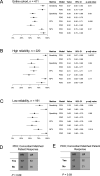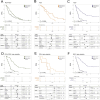This is a preprint.
Comparative analysis of patient-derived organoids and patient-derived xenografts as avatar models for predicting response to anti-cancer therapy
- PMID: 40832408
- PMCID: PMC12363698
- DOI: 10.1101/2025.08.10.25333051
Comparative analysis of patient-derived organoids and patient-derived xenografts as avatar models for predicting response to anti-cancer therapy
Abstract
Patient-derived xenografts (PDX) and organoids (PDO) are widely used to model cancer and predict treatment response in matched patients. However, their predictive accuracy has not been systematically studied nor compared. We conducted a systematic review and meta-analysis of studies using PDX or PDO from solid tumors treated with identical anti-cancer agents as the matched patient, identifying 411 patient-model pairs (267 PDX, 144 PDO). Overall concordance in treatment response between patients and matched models was 70%, with no significant differences between PDX and PDO. Sensitivity, specificity, positive and negative predictive value were also comparable. Patients whose matched PDO responded to therapy had prolonged progression-free survival. For PDX, this association held only when analyses were restricted to patient-model pairs with low risk of bias after applying a bias assessment metric. Together, these findings suggest that PDO perform similarly to PDX in predicting matched-patient response, while potentially offering lower financial and ethical burdens.
Keywords: PDO; PDX; avatar; organoid; xenograft.
Conflict of interest statement
Conflicts of interest: The authors have no relevant conflicts of interest to declare.
Figures




References
-
- Mateo J, Steuten L, Aftimos P, et al. Delivering precision oncology to patients with cancer. Nat Med. 2022;28(4):658–665. - PubMed
-
- Zanella ER, Grassi E, Trusolino L. Towards precision oncology with patient-derived xenografts. Nat Rev Clin Oncol. 2022;19(11):719–732. - PubMed
-
- Ehlen L, Schmueck-Henneresse M. The rise of patient avatars in precision oncology. Nat Biotechnol. 2024;42(8):1173–1174. - PubMed
Publication types
Grants and funding
LinkOut - more resources
Full Text Sources
